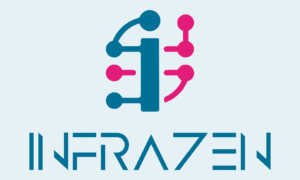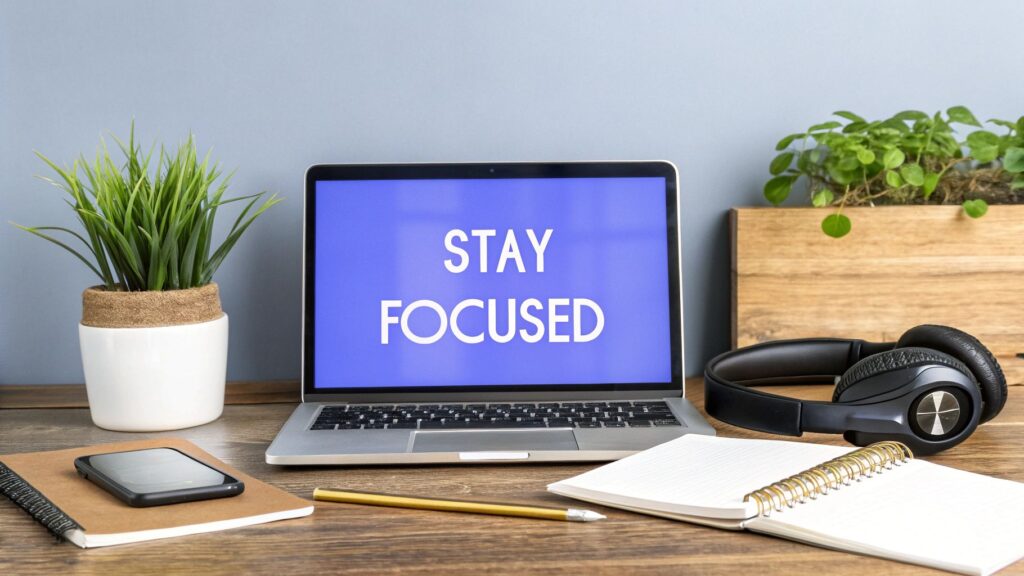Juggling client feedback, team messages, and the constant pressure to innovate is a familiar challenge for UK creatives. If you are looking for ways to focus better at work, you need to move beyond generic advice. It is time for strategies built for the messy, brilliant, and unique demands of creative projects. It is about reclaiming your attention to do the deep, meaningful work that truly defines your craft.
The UK Creative's Battle Against Distraction
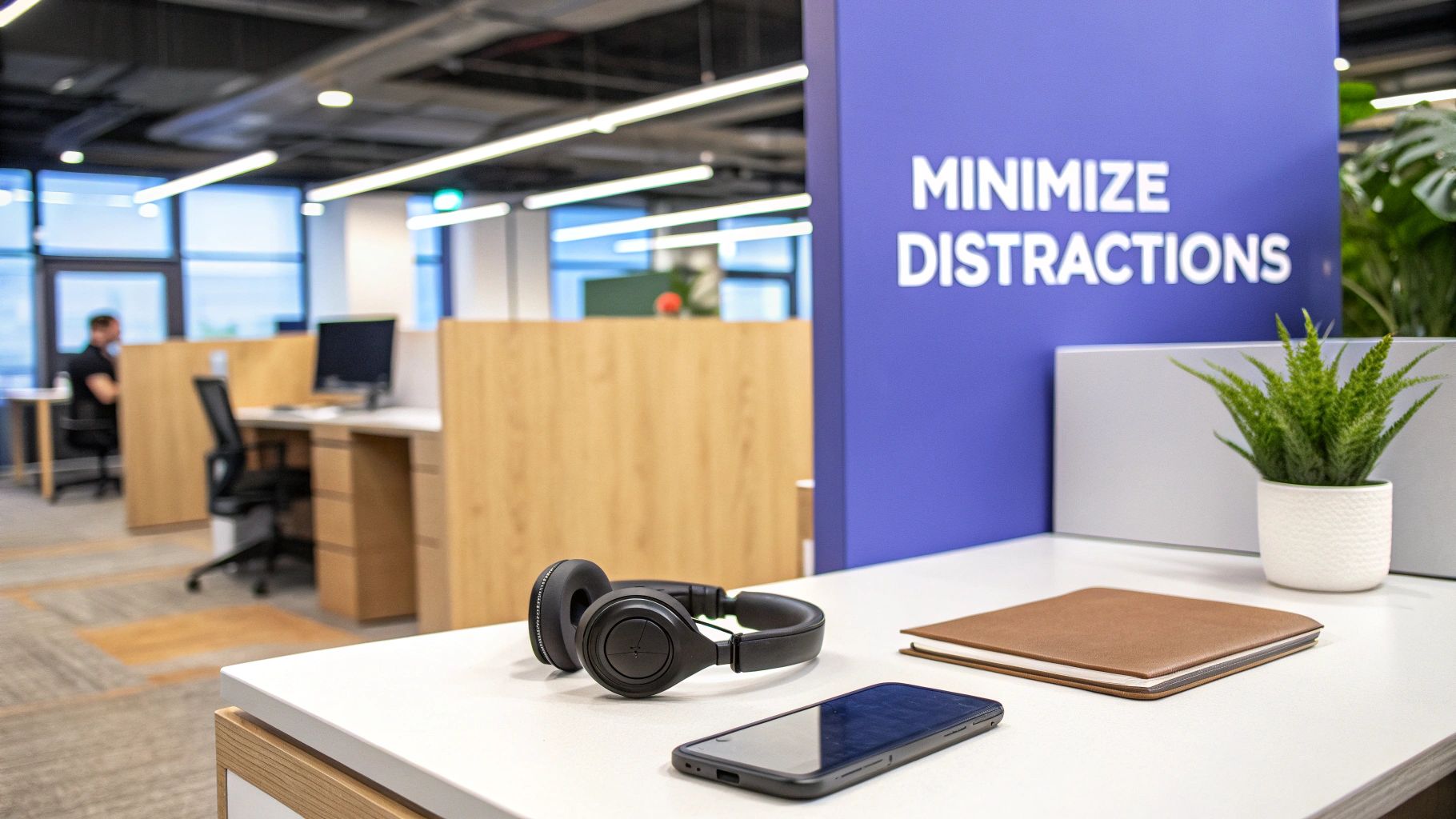
For creatives in the UK, the workday is rarely a straight line. It is more of a chaotic dance between collaborative sprints, solitary deep thinking, and the sudden "can you just…" from a client. This constant context switching shatters our attention, making sustained concentration feel like a remote possibility.
The pressure is significant, and the data shows a challenging picture of the modern workplace. The average UK employee is genuinely productive for just 2 hours and 53 minutes of their eight-hour day. This is not just a number; it highlights a nationwide challenge with focus. This problem is especially sharp in our industry, where output is measured in quality and inspiration, not just hours logged. You can explore more on these UK workplace productivity stats to see the full scope.
This guide is for you: the creative freelancers, agencies, and studios across the UK. We understand. Your challenges are unique. Generic productivity tips often fall flat because they do not account for the non-linear, often unpredictable, nature of creative work.
Why Standard Advice Falls Short for Creatives
Most productivity advice assumes a predictable, task-based workflow. But for a graphic designer exploring concepts, a copywriter chasing a fleeting idea, or an art director juggling multiple projects, the path to completion is anything but straightforward.
Here is what makes focus so tough in our field:
- Non-linear work: Creative breakthroughs do not stick to a 9-to-5 schedule. Your best ideas might surface after hours of what looks like unproductive exploration.
- Constant feedback loops: Just when you find your flow, an email pings. The need to integrate feedback from clients and teammates can instantly break your concentration.
- The pressure to innovate: Real creativity needs mental breathing room, something that is hard to find when your day is filled with digital noise and administration.
This guide will not just tell you to "turn off notifications." We are diving into practical, tested methods to build an environment and a mindset that actively protects your focus. It is about cultivating your ability to produce high-calibre creative work, day after day.
We will cover how to master your physical and digital spaces, adopt powerful mental frameworks, and finally silence the noise so you can get back to what you do best.
Crafting a Workspace That Cultivates Focus
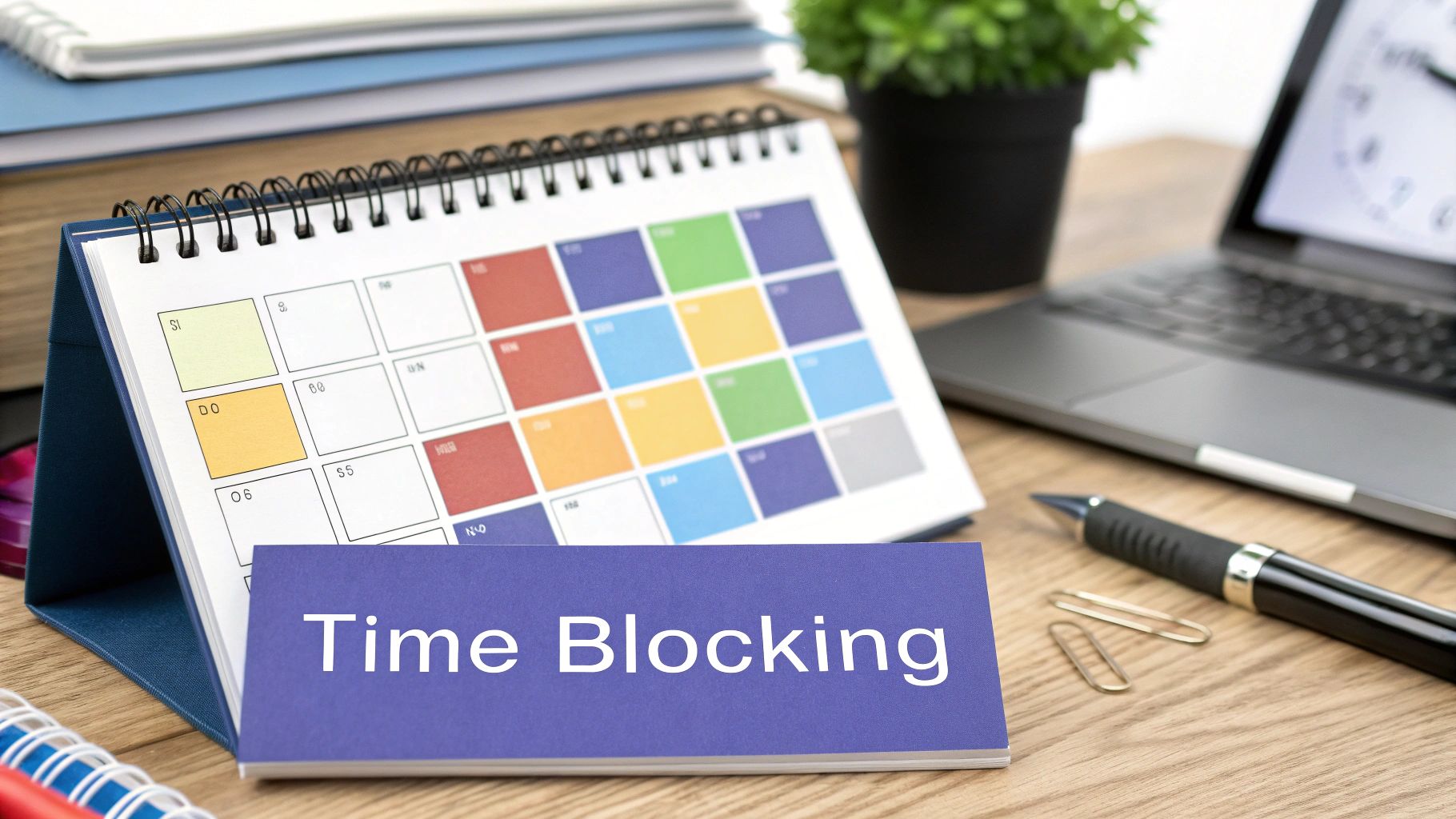
Your physical environment is more than just a place to put your laptop; it is a powerful tool that can either fuel or stifle your best ideas. For creatives, a workspace should be a sanctuary for concentration, not a battlefield of distractions. The goal is to consciously engineer a space that signals 'focus time' to your brain, making it far easier to drop into a state of deep work.
It is surprising what a few simple adjustments can do. They can have a considerable impact on your ability to concentrate and, ultimately, deliver high-quality creative output.
This is not just a beneficial addition, either. The link between environment and performance is backed by solid data. For instance, UK regional productivity figures show that while London and the South East have historically led, areas like the North West have seen significant growth post-pandemic. It is a clear sign that a focused work environment can thrive anywhere, provided the right conditions are met. This proves that building a space for concentration is a real lever for better performance. You can read more on these UK regional productivity insights to see the bigger picture.
Optimise Your Ergonomics and Lighting
Physical discomfort is a silent enemy of focus. You cannot solve a tricky creative problem when an aching back or strained eyes are constantly demanding your attention. That is why a proper ergonomic setup is not a luxury; it is a non-negotiable investment in your concentration.
Your monitor should be at eye level, and your chair needs to support your posture so your feet can rest flat on the floor. It is a small detail, but it makes a significant difference over an eight-hour day. If you are based in the UK, it is worth looking into an ergonomic assessment or checking out local suppliers for adjustable desks.
Lighting is just as critical. Poor lighting leads to eye fatigue and headaches, while harsh, sterile overhead lights can destroy inspiration.
- Go for Natural Light: Whenever you can, position your desk to take advantage of natural light. It is a proven mood and alertness booster.
- Layer Your Lighting: Do not rely on a single overhead bulb. Use a mix of ambient light for the room, task lighting (like a good desk lamp), and perhaps some accent lighting to create a space that feels comfortable and visually engaging. Warm, soft white bulbs (around 2700K-3000K) are great for creating a cosy, focused atmosphere.
Manage Noise and Sensory Input
Whether you are in a bustling open-plan agency or a quiet home studio, noise is one of the biggest focus-breakers. Finding the right audio balance is key to protecting your mental space.
Your ability to focus better at work often comes down to controlling what you see and hear. By deliberately curating your sensory inputs, you create an invisible barrier that guards your concentration against constant interruptions.
A great pair of noise-cancelling headphones is a creative’s best friend, especially in shared spaces. They are a universal sign for "do not disturb" and they genuinely block out distracting chatter. If total silence feels a bit oppressive, apps that play ambient sounds like coffee shop murmurs or gentle rain can be brilliant for masking more jarring, unpredictable noises.
This kind of structured approach to your physical and sensory environment feeds directly into a more organised workflow. When you remove these external frictions, you free up precious mental capacity. This is absolutely essential for effective creative workflow management. When your space works for you instead of against you, all your energy can go towards the work that truly matters.
Your digital tools should be your most trusted creative allies, but they are often the biggest enemies of focus. The endless pings, pop-ups, and notifications from the very apps we depend on can completely derail a creative train of thought. Learning how to focus better at work goes beyond the usual advice; it means actively reconfiguring your technology to serve your process, not sabotage it.
For a creative professional in the UK, this is not about abandoning technology. It is about taking back control and shaping your digital environment into a place that fosters deep, uninterrupted work. It all starts with an honest 'digital audit'.
Conduct a Ruthless Digital Audit
It is time for a proper clear-out. Take a hard look at every single app, subscription, and browser extension you have installed. Ask yourself one simple question: does this tool genuinely help my creative work, or is it just another source of distraction?
Be ruthless. That third social media scheduler you have not touched in months? The news aggregator that just fuels your scrolling? They are quietly eating away at your focus budget.
Here is a simple framework to guide you:
- Categorise Your Tools: Split them into three lists: 'Essential' (think Figma, Adobe Creative Cloud), 'Helpful but Distracting' (Slack, email), and 'Non-essential' (everything else that did not make the first two lists).
- Cull the Unnecessary: Get rid of everything in the 'Non-essential' category. Uninstall the apps. Cancel the subscriptions. This one action creates a surprising amount of mental clarity.
- Create Intentional Friction: For the 'Helpful but Distracting' tools, make them harder to access. Move their icons off your phone's home screen or your main desktop. That tiny bit of extra effort forces you to be deliberate about opening them, rather than doing it on autopilot.
This exercise transforms your tech from a chaotic mess of interruptions into a curated set of powerful creative instruments. If you are looking for more ways to streamline your setup, our guide on tech tools for creatives offers some great ideas for simplifying your workflows.
Configure Your Tools for Focus
Once you have pared down your digital toolkit, the next job is to configure your essential apps for dedicated, deep work. Most creative platforms have built-in features to reduce visual noise, but hardly anyone uses them. In Adobe Illustrator or Photoshop, for example, just tap the 'F' key to cycle through screen modes. It hides all the toolbars and menus, letting you immerse yourself completely in your design.
Browser extensions are also a great help for focused creative sprints. Do not just rely on willpower; install a good site blocker. You can set it to block access to news sites, social media, or your favourite online shops during predefined work periods.
A common myth is that intense focus requires superhuman discipline. The reality is much simpler: it is about building an environment where you do not need as much discipline. When you set up your digital tools to work for you, focus becomes the default.
The same logic applies to your communication apps. In Slack, do not just mute notifications. Set your status to "Deep Work" and tweak your settings to only receive alerts for direct mentions or urgent keywords. This sends a clear signal to your colleagues that you are off-limits for casual chats, allowing you to stay submerged in complex creative problem-solving.
Speaking of focused work sprints, the technique shown below is a classic for a reason.
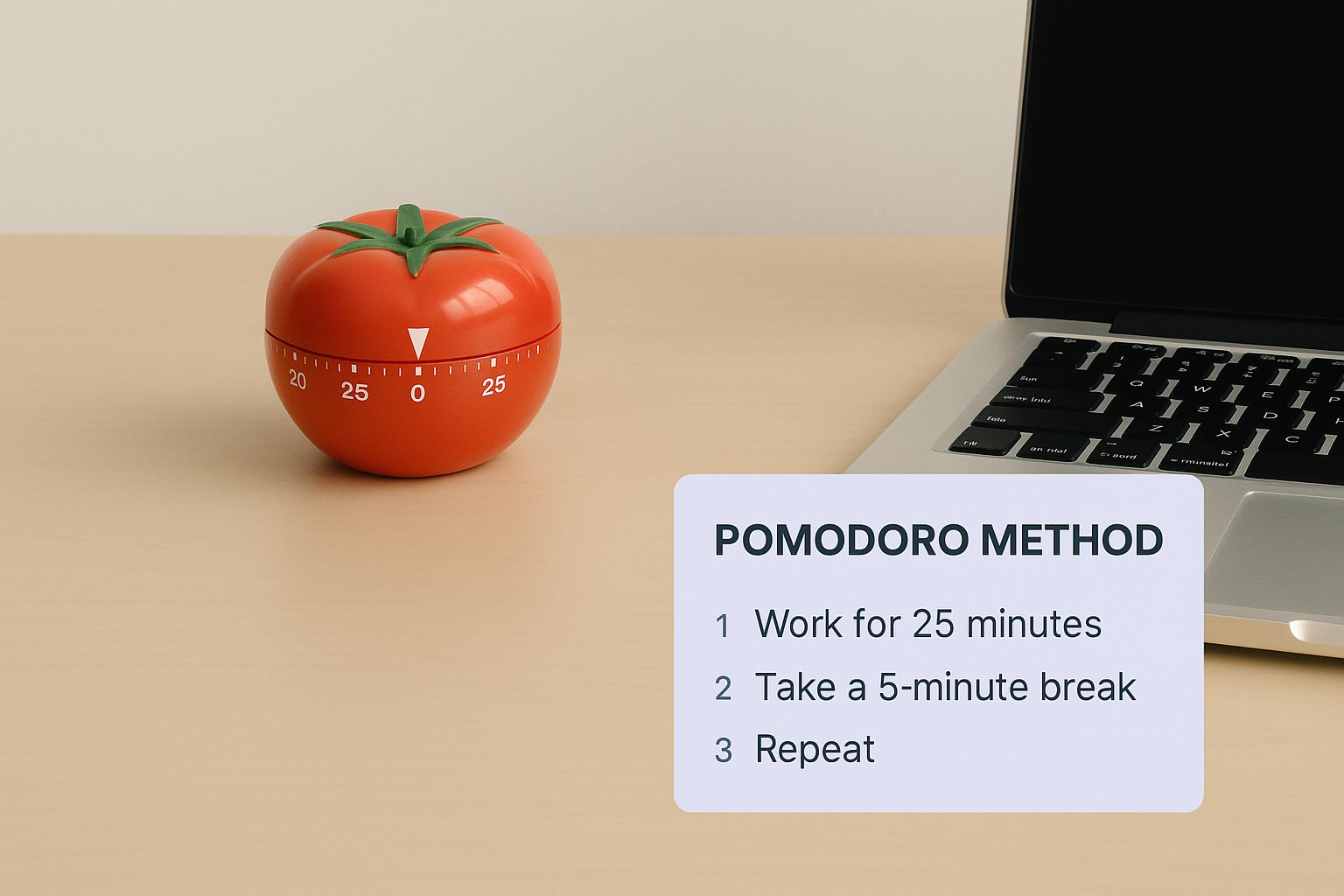
This image breaks down the Pomodoro Technique, a brilliant method for structuring work into focused intervals followed by short breaks. It is the perfect partner to a well-managed digital environment. By mastering your digital toolkit first, you create the ideal conditions for these productive bursts, leading to higher-quality creative work and less mental burnout.
Adopting Mindsets for Sustained Concentration
You have sorted your physical and digital workspaces, but the biggest hurdle in learning how to focus better at work is usually inside our own heads. Sustained concentration is not about brute-force willpower. It is about the mental models you live by. For creatives, whose work rarely follows a straight line, this means ditching rigid systems for something more flexible and powerful.
First, let us bust a common myth. The modern obsession with multitasking is a productivity killer, especially in creative roles. Juggling projects does not make you more efficient; it just slices your attention into tiny, useless pieces and dilutes your best ideas. The real superpower here is single-tasking: pointing all your brainpower at one creative problem until it is solved. That is where you find the flow state, where true progress happens.
Embrace Structured Focus Time
Creative work can feel messy and unpredictable, but your approach to focus does not have to be. Frameworks like Time Blocking and the Pomodoro Technique are fantastic starting points, but they need a slight adjustment for the way creatives work.
Instead of rigidly scheduling "write copy for 25 minutes," try something like "explore headline concepts for 25 minutes." It is a small shift, but it acknowledges that creative progress is not just about tangible output. It is also about the journey of exploration and developing ideas.
- Time Blocking for Creatives: Carve out large blocks of your day for specific projects. Think "Client X Branding Concept" from 10 am to 1 pm. This creates a protective bubble for deep, immersive work.
- The Pomodoro Technique: This is very helpful when you feel stuck or are dealing with more granular tasks. A focused 25-minute sprint followed by a five-minute break keeps your energy up and prevents burnout during long sessions.
The goal is not to force creativity into a box. It is to build a reliable container that protects your focus from the constant barrage of external demands, giving your best ideas the space they need to emerge.
This structured approach has a much bigger impact than you might think. As of early 2025, a staggering 70.9% of workers in the UK were employed by firms with labour productivity below the national average. This points to a huge, systemic challenge with workplace focus. If you are curious, you can dig into these employee productivity statistics for 2025.
Schedule Your Distractions
This might sound counterintuitive, but one of the best ways to protect your focus is to actively plan for distractions. Give them their own dedicated time slot. Instead of letting emails and Slack messages chip away at your attention all day, schedule two or three "distraction windows."
For instance, you could block out 15 minutes at 11 am and 3 pm to clear your inbox and handle non-urgent pings. Outside of those times? Notifications are off. This mental shift is liberating. It frees you from the low-level anxiety of feeling like you must be "always on" and trains your brain to tackle admin in batches, leaving the rest of your day free for deep, creative thinking. It also has the welcome side effect of setting clearer expectations with clients and colleagues.
These mental strategies and your tech setup go hand-in-hand. When you build strong internal boundaries, you create the perfect conditions for a well-optimised IT system to shine. This is absolutely essential for unleashing creativity, as better IT processes can fuel your ideas. When your mind and your tools are finally aligned, sustained concentration starts to feel less like a struggle and more like second nature.
You have now improved your personal focus. That is a significant win. But for a creative agency or studio here in the UK, true, lasting concentration is a team effort. If you really want to elevate your team's output, you have to build a culture where deep work is protected and interruptions are the exception, not the rule.
This is the big shift: moving from just individual habits to a shared, team-wide policy. It is how you collectively learn to focus better at work.
It all starts with a new social contract around communication. The constant ping of notifications and the unspoken pressure to reply instantly are damaging to creative flow. As a team, you need to agree on clear, respected boundaries that give everyone permission to disconnect and really concentrate.
This is not about building walls or ignoring colleagues. It is about creating predictable patterns that everyone understands and, crucially, respects.
Establish Core Deep-Work Hours
One of the most powerful moves you can make is to introduce ‘deep-work hours’ across the whole team. This is a dedicated, daily block of time, say, from 10 am to 12 pm, where all non-urgent communication just stops. No casual Slack messages, no "got a quick question?" shoulder taps, and absolutely no internal meetings.
This simple policy creates a daily sanctuary for concentration. When your entire team knows this two-hour window is sacred, they can finally sink into complex tasks without that nagging fear of being derailed. It empowers your designers, writers, and strategists to do their best work, safe in the knowledge they will not be pulled away.
To make this stick, you need to get your tools on board with the policy.
- Shared Calendars: Block out these core hours in everyone’s calendar so they are visibly booked. This makes it simple for people to schedule meetings around them, not through them.
- Slack Statuses: Make it standard practice to use clear statuses like "Deep Work until 12 pm". It is a simple digital signpost that reinforces the boundary.
- Project Management Tools: Jump into your project management tools like Asana or Trello and tame the notification noise. Does the whole team really need an alert for every single card that gets moved? Probably not.
Manage Client Expectations Proactively
Protecting your team's focus often means you have to manage expectations outside the studio walls, especially around response times. Many UK agencies feel that pressure to be "always on" for their clients, but this comes at a huge cost to the very creative energy those clients are paying for.
You can absolutely protect your team's creative flow without damaging client relationships. The key is clear, proactive communication that sets boundaries from the start of a project, not in the middle of a crisis.
Instead of being purely reactive to every email that lands, set clear expectations in your project kick-off meetings and onboarding documents. Let clients know your team’s core working hours and establish a realistic response window for non-urgent queries, something like "within four business hours" works well.
You will find that most clients will respect these boundaries as long as they are communicated clearly and professionally from the start. This one simple act dramatically reduces team anxiety and frees them from the tyranny of the inbox. It allows them to channel their energy where it matters most: producing the exceptional creative work your clients hired you for in the first place.
Your Questions About Workplace Focus, Answered
Even with the best plan, trying to sharpen your focus at work presents some tricky situations. As a creative in the UK, you are juggling unique pressures, so let us tackle a few of the common roadblocks that appear when you are trying to build these new habits.
We will get straight to the point with actionable advice for the real-world sticking points you are likely to face.
How Do I Stay Focused When My Work Is So Collaborative?
This is a significant challenge in any creative agency. The answer is not to become isolated, but to bring some structure to your collaboration. It all comes down to separating 'collaboration time' from 'concentration time'.
Use those deep work hours we talked about for your solo tasks: the design, the writing, the coding. Then, be intentional about scheduling specific, focused blocks for brainstorming, reviews, and feedback sessions.
When it is time to collaborate, be fully present. But when it is your time to focus, be unapologetically unavailable. This approach respects both the team's need for synergy and your need for individual creative space.
What if I Get a Brilliant Idea Outside My 'Focus' Time?
This is a classic creative's dilemma. Brilliant ideas rarely check your calendar before showing up. The fear of losing a sudden flash of inspiration can make it hard to truly disconnect and sink into a task.
The solution is surprisingly simple: create a frictionless 'idea capture' system.
This could be a dedicated notebook, a voice memo app on your phone, or a simple text file you keep open on your desktop. The moment an idea hits, get it down immediately with just enough detail to jog your memory later. Then, let it go. Move on with your planned task, confident that your spark of genius is safely stored and waiting for you.
The goal is not to shut down spontaneous creativity but to give it a designated place to live. This frees up your mind from the burden of holding onto fleeting thoughts, which is a major drain on your focus.
I have Tried Things Like the Pomodoro Technique and It Felt Too Rigid. What Now?
I hear this often, especially from creatives whose work does not fit neatly into 25-minute boxes. If a strict timer feels more like a prison than a tool, then change the rules. Maybe your ideal focus sprint is 45 minutes, or even a solid 90.
The principle is what matters, not the exact prescription. The core idea is simply to work in focused bursts followed by a proper break.
Experiment. Find a rhythm that matches your natural energy cycles and the demands of your creative process. The aim is to build a structure that serves you, not a cage that confines you. Treat these popular frameworks as starting points, ready to be customised for your unique way of working.
Your ability to produce exceptional creative work is directly tied to your capacity for deep focus. But when IT issues, security worries, and digital distractions are constantly pulling you out of the zone, your best ideas never get the oxygen they need. InfraZen Ltd provides specialist IT support for UK creative agencies, quietly managing the tech so you can concentrate on your craft. Stop letting technology interrupt your flow and discover how calm, focused IT can transform your creativity.
